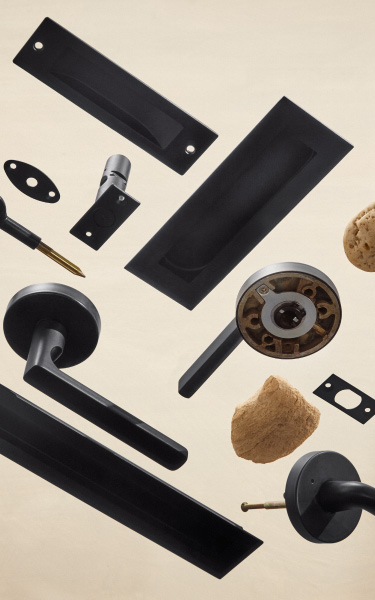Hardware 101
Door hardware A-Z glossary
Door Hardware refers to any items that are attached to a door to enhance its functionality or appearance. If you’re working with a builder, or doing a DIY renovation it’s important to understand what the terms are, so you get the right door hardware for your project. Below are some common door hardware terms to help get you started.
Backset
The backset is the distance from the edge of the door to the centre of the hole for your lever or knob.
Barrel
A cylindrical portion of the cylinder that rotates when the correct key is used.
Construction Cylinder
The Construction cylinder allows the builder to use a ‘construction key’ during the building phase. After the homeowner’s keys are used, the lock’s internal pinning arrangement alters to prevent any future use of the construction keys.
Construction Key
This is a common term used if you’ve engaged a builder to carry out work for you. There is only one key cut. This key allows the builder to gain entry during the building phase. On completion of the work the key becomes inoperative, preventing further entry by the builder.
Cylinder
The cylindrical shaped mechanism housed within door locks that contains the tumbler and keyway, into which a key is inserted to operate the lock.
Centre to Centre
This can be referred to as CTC. Centre to Centre is the measured in millimeters and is the measurement between two fixing points and often applies to Pull Handles. It is useful when you need to match pre-drilled holes.
Deadbolt
A bolt engaged by turning a turn or key.
Double Cylinder
A locking cylinder barrel that is controlled by a key on both the internal and external side of the door. Commonly found in entrance sets or deadbolts on external doors.
Door Closer
After a door has been opened, this device automatically closes the door in a controlled manner to prevent it from slamming or to ensure latching.
Door Preparation
The cut-outs or holes made to the door for the lock being installed.
Dummy
A face-fixed lever or knob that matches your passage and privacy sets, for use on a cupboard or wardrobe door. Usually sold as singles not pairs and does not come with a latch. When supplying a dummy set for a right door you may need to check the required handing.
Escutcheon
This is a cap that covers the base of a rose.
Flush Bolt
The Flush Bolt is recessed into the edge of the inactive leaf of a pair of doors at the top and/or bottom to secure the door.
Handed Products
Handed Products are designed for use only on right hand doors or only on left hand doors, but not both. This could be due to the style or functionality of the product.
Hold-Back
A catch on a lock which can hold the latch bolt in the retracted position.
Hold-Open
The feature of a door closer unit which enables a door to be held in the opened position until released.
Jamb
The Jamb is the frame that surrounds the door in the doorway.
Latch
The mechanism that is installed into the edge of the door and retracts or protrudes with the turn of the doorknob or lever. The latch keeps the door closed and allows it to open.
Lockset
A lockset is a complete set of hardware, it can include a latch, a strike and door furniture, such as knobs, levers, escutcheons, or handles.
Magnetic Catch
A magnetic catch is a latching mechanism that uses a magnetic force to hold two objects together. Often used on non-latching wardrobe doors with dummy furniture.
Master Key
This is a key that can open two or more locks which makes it convenient for the facility or site manager to have control over an entire building/s.
Mortice Lock
A lock which is set within the body of a door in a recess or mortice, as opposed to one attached to the door surface.
Passage Set
A Passage Set is a door handle set with a non-lockable function. Generally, a latch allows free access through the door from both sides. Suitable for internal doors that don’t need to be locked.
Privacy Pin
Usually used on a bathroom or bedroom door, the privacy pin allows the door to be locked from one side. This pin is located on the rose of the door knob or lever.
Privacy Set
A term for locks used on bathroom and bedroom doors having an internal button, pin or snib to lock the outside handle and an emergency function which will unlock the set from the outside.
Rebate
This is the groove which is cut into the door frame and is what the latch is attached to. This then allows the door to strike correctly as it closes.
Non-Handed Lock/Reversible Lock
This is a lock that enables you to open with any hand (left or right).
Rim Lock/Rim Latch
A lock or latch which is fixed to the surface of a door, rather than inserted along the edge of the door.
Rose
The rose is a circular plate on which the door handle or knob is mounted.
Roller Latch
The roller catch has a spring-loaded roller held within a cylinder attached to a flange. The catch is recessed into the edge of the door while the striker plate is recessed into the jamb. Usually used with a dummy trim or pull handle.
Rosette
A Rosette is the cover the goes over the rose.
Single Cylinder
A locking barrel operated by a key on the outside and a turn or snib on the inside for an easy exit in an emergency.
Snib
A snib is a part of the door handle and is used to either lock or unlock the door.
Spacer Rings
The spacer ring fits between the door and the handle for thin doors.
Spindle
The spindle connects the door lever or knob to the latch or locking mechanism to operate the bolt.
Stile
The vertical edge of the door where door furniture is fixed. A thin stile i.e. one with a glass pane near the edge of the door may have implications for which backset can be used.
Strike/Strike Plate
The metal piece attached to the door jamb. As the door closes, the latch mechanism strikes the plate mounted to the jamb and the strike plate catches the mechanism and holds the door closed.
A metal plate fixed in or on a doorjamb where the lock or latch bolt engages when the door is closed.
Tubular Bolt
A bolt that has a round cylinder hole in the door edge rather than a chiselled rectangular shape used for mortice locks.
Turn
A small interior piece that can be turned with your finger and thumb to lock or unlock a door lock.


